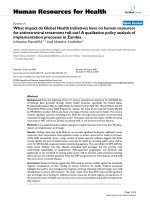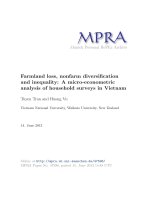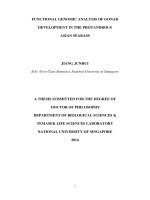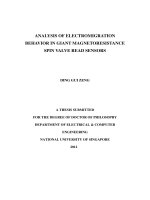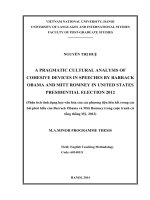A multilevel configurational analysis of resource integration in net enabled retail organizations
Bạn đang xem bản rút gọn của tài liệu. Xem và tải ngay bản đầy đủ của tài liệu tại đây (1.8 MB, 185 trang )
i
AMULTILEVELCONFIGURATIONALANALYSIS
OFRESOURCEINTEGRATIONIN
NET‐ENABLEDRETAILORGANIZATIONS
OHLIHBIN
M.Sc.(Info.Sys.),NUS
B.Sc.(Hons.I)(Comp.&Info.Sci.),NUS
ATHESISSUBMITTED
FORTHEDEGREEOFDOCTOROFPHILOSOPHY
DEPARTMENTOFINFORMATIONSYSTEMS
NATIONALUNIVERSITYOFSI NGAPORE
ii
ACKNOWLEDGEMENTS
Thecompletionofthisdissertationservesasthecapstonetomyarduousyet
fulfilling doctoral program. Reaching this stage of my life would not be
possiblewithoutthehelpofmanypeople.
First and foremost, I would like to express my deepest gratitude to my
dissertationadvisor,ProfessorTeoHockHai.Overtheyears,myintellectual
capacitieshavebeenhonedunderhismeticulousguidanceandinspirational
coaching. I thank him for the faith and encouragements given during the
difficulttimes. Asboth myresearchadvisor and lifementor, hehas shaped
myperspectiveandoutlookonamultitudeofthings.Asweendourformal
advisor‐adviseerelationship,Iamlookingforwardtocontinuelearningfrom
himasalifelongcolleagueandspecialfriend.
IamalsoindebtedtoProfessorWeiKwokKee,whoservedastheadvisorfor
my undergraduate honors and master theses. He has inducted me into the
fascinatingworldofacademicresearch.Thoseformativeresearchexperiences
playedapivotalroleinprovidingmewithagoodresearchfoundation.Iam
alsoespeciallytouchedbyhisconcernsontheprogressofmydoctoralwork
andhisadvicesoncareerdevelopment.
Next, I would like to show my appreciation to
Professor V. Sambamurthy,
whohostedmedu ringmyfour‐monthvisittothe MichiganStateUniversity.
I have benefited tremendously from attending his doctoral seminar and
workingwithhimonresearchpapers.ThebriefstintinEastLansinghasbeen
lifechanging and memorableand hasbroadened myhorizons immensely.
I
also thank Professors Bernard Tan and Chan Hock Chuan for providing a
conducive research environment in the de partment and for making special
teachingarrangementstomakemyvisittoMSUpossible.
Student research mentoring played an integral part in contributing to my
researchcompetence.Ithanktheeighthonorsyearprojectstudentsandtwo
independent study project students whom I am very fortunate to have the
chancetoworkwith.SpecialthanksgotoWilliamRimbunandParvathiNair
fortheirgreatassistanceinthetwopilotstudies.
iii
This dissertation and my other research works have also improved
substantiallyfrompresentationsandseminarsmadeinSingaporeandvarious
overseasconferences.Ithankeverycolleaguefortheirconstructivefeedback.
IamalsothankfultoallmypastCS1105ComputingandSocietyandGEK1511
Introduction to Computing students. The enjoyable and satisfying teaching
experiences have to a large extent rejuvenated my otherwise monotonous
researchregime.
Specialthanksalsogotomypersonalfriendswhohavebeenverysupportive
tomyseeminglyperpetualpursuitfortheterminaldegree.Iamalsograteful
to many of my NUS colleagues and friends for their help in one way or
anothertomyteachingandresearchactivities.
Lastly, and most importantly, my family has been a driving force to the
completionofmyPh.D.Notonlyhavetheyprovidedmewithunconditional
moralsupportandunderstanding‐myDad,MumandSishadevenchipped
inwithprofessionalsecretarialandlogisticalhelptoprepareanddeliverthe
surveymailpackages.Idedicatethisdissertationtothem.
iv
CONTENTS
Title……………………………………………………………………………… i
Acknowledgements…………………………………………………………… ii
Contents………………………………………………………………………… iv
Summary………………………………………………………………………… vii
Tables…………………………………………………………………………… x
Figures……………………………………………………………………………. xi
Chapter1 Introduction………………………………………………………. 1
1.1 EmergenceofNet‐enabledRetailOrganizations ……………. 2
1.2 PriorResearchinHybridCommerce………………………… 4
1.3 MotivationsandResearchObjectives………………………… 8
1.4 TheoreticalLensUsedforResearch……………………………. 10
1.5 FrameworkofDissertation……………………………………… 12
1.6 PhasesofResearch……………………………………………… 13
1.7 ResearchContributions………………………………………… 14
Chapter2 Essay1:
AStrategicGroupAnalysisofNet‐enabledRetail
Organizations……………………………………………………
16
2.1 Introduction……………………………………………………… 16
2.2 ConceptualFoundations………………………………………… 19
2.2.1StrategicGroupsApproachtoDeriving
Configurations……………………………………………
19
2.2.2MobilityBarriersandPerformanceImplicationsof
StrategicGroups……………………………………………
21
2.3 DimensionsUsedtoDevelopStrategicGroups………………. 24
2.4 SurveyDataCollection………………………………………… 28
2.5 AnalysisandResults………………………………………… … 31
2.5.1ClusterAnalysis……………………………………………. 31
2.5.2ValidationoftheTaxonomy……………………………… 38
2.5.3LinkagebetweenStrategicGroupsandFirm
Performance………………………………………………
43
2.6 DiscussionandImplications…………………………………… 48
2.6.1Net‐enabledRetailOrganizationalConfigurations……. 48
2.6.2MobilityBarriersandStrategicGroup‐Performance
Linkage………………………………………………………
50
2.6.3Limitations,FutureResearchandImplications………… 52
2.7 Conclusion………………………………………………………… 57
v
Chapter3 Essay2:
AStructural‐StrategyFitAssessmenttoRealizeBusiness
ValueinRetailChannelIntegration…………………………
58
3.1 Introduction……………………………………………………… 58
3.2 TheoreticalFoundations…………………………………………. 60
3.2.1TheMilesandSnowBusinessStrategyTypology……… 60
3.2.2OrganizationalStructureasaContinuumof
DifferentiationandIntegration…………………………
64
3.3 DefiningtheMultichannelHybridRetailOrganizational
Structure……………………………………………………………
65
3.4 OrganizationalStructureFitwithStrategicTypeand
Performance………………………………………………………
69
3.5 Method.……………………………………………………………. 71
3.5.1SurveyDataCollection……………………………………. 71
3.5.2OperationalizationofConstructs………………………… 73
3.5.3IdentificationofIdealHybridOrganizationalStructure
Profile………………………………………………………
77
3.5.4FirmPerformance………………………………………… 79
3.5.5ControlVariables………………………………………… 79
3.6 DataAnalysis…………………………………………………… 80
3.6.1ScaleValidation…………………………………………… 80
3.6.2AssumptionsValidation………………………………… 81
3.6.3TestingConfigurationTheoryPredictionswithProfile
DeviationAnalysis…………………………………………
83
3.7 Results…………………………………………………………… 85
3.7.1DescriptiveStatisticsforProspectors,Analyzersand
Defenders……………………………………………………
85
3.7.2PerformanceImplicationsofCoalignment……………… 85
3.8 DiscussionandImplications…………………………………… 88
3.9 LimitationsandFutureResearch……………………………… 93
3.10 Conclusion………………………………………………………… 95
vi
Chapter4 Essay3:
ANewServicesDevelopmentPerspectiveofthe
AntecedentsandConsequencesofRetailChannel
Integration…………………………………………………….
96
4.1 Introduction………………………………………………… 96
4.2 ConceptualIntegrationandModelDevelopment……… 100
4.2.1NewServicesDevelopmentandRetailChannel
Integration………………………………………………
100
4.2.2DimensionsofRetailChannelIntegrationinNet‐
enabledRetailOrganization…………………………
103
4.2.3AntecedentsofRetailChannelIntegration:IT
InfrastructureandHumanResourceCapabilities…
110
4.2.4RelationshipbetweenRetailChannelIntegration
andOrganizationalCompetences…………………….
114
4.2.5DriversofOrganizationalPerformance:Exploitative
CompetenceandExplorative
Competence……………………………………………
117
4.2.6ControlVariables………………………………………. 119
4.3 ResearchMethod.……………………………………………. 120
4.3.1SurveyDataCollection……………………………… 120
4.3.2OperationalizationofConstructs…………………… 121
4.4 DataAnalysisandResults………………………………… 125
4.4.1EvaluationoftheMeasurementModel……………… 127
4.4.2TestingoftheStructuralModel……………………… 130
4.4.3ConsequencesofRetailChannelIntegration……… 132
4.5 DiscussionandImplications………………………………… 135
4.6 Conclusion…………………………………………………… 145
Chapter5 ResearchNote:
DoStrategicGrouporFirmDifferencesExplainFirm
PerformanceBetter?AHierarchicalLinearModel
Analysis………………………………………………………
146
5.1 Introduction……………………………………………………. 146
5.2 StrategicGroupandFirmDifferencesAffectPerformance. 147
5.3 HierarchicalLinearModeling(HLM)Analysis……………. 149
5.4 Results………………………………………………………… 151
5.5 Discussion……………………………………………………… 152
Chapter6 Conclusion…………………………………………………… 154
References…………………………………………………………………… 157
Appendix……………………………………………………………………… 172
vii
SUMMARY
In recent years, the retail industry has witnessed heightened use of
information technologies as firms have increasingly applied digitization to
integrate theirbusiness processes and retail channels. They strive to deliver
new services and enhanced customer experiences in order to sustain
operationalexcellence.Thisdissertationfocusesuponhowthesenet‐
enabled
retail organizations (NERO) transform themselves to embrace the hybrid
commerce business model to conduct business with consumers through the
provisionofintegratedinformationandinnovativecross‐channelservices.
Drawing on the literature of information systems, strategic
management,andserviceoperationsmanagementaswellasrecenttheoretical
developments in organizational resource
integration and new service
developments,amultilevelconfigurationalanalysisonretailchannelresource
integration was performed. We examine how the organizational resource
integrationofinformationtechnologies,humanresources,businessprocesses,
and customer channels impacts business performance. Survey data was
collectedfromseniorexecutivesin125NEROsinSingapore.
InEssay1,weprovidedastrategicgroupsanalysisofthecurrentstate
ofhybridcommerceintheretailindustry.Weusedclusteranalysistodevelop
a taxonomy of four distinct types of organizational configurations: novice
integrators, people‐focused integrators, IT‐focused integrators and all‐
viii
rounded integrators. We draw insights from the performance differences
betweentheseintegrators.
In Essay 2, we applied the profile deviation approach to assess the
coaligment between hybrid organizational structure and generic business
strategies of prospectors, analyzers and defenders. Results suggest that
organizations that have hybrid structures that are most similar to the high‐
performingorganizationsof theirstrategictypeperformed betterthanthose
whosefirmprofiledeviatedfromtheidealprofile.
In Essay 3, we examined how the organizational integration of
resources within a firm can nurture innovation competences and impact
business performance. Results from the Partial Least Squares (PLS) analysis
suggest that IT capability and human resources capabilities are both
significantantecedentsofthelevelofretailchannelintegration.Furthermore,
higher levels of organizational integration facilitate the development of
exploitative and explorative competences and lead to higher organizational
performance.
Finally,inthebriefResearchNote,weusedhierarchicallevelmodeling
(HLM) to simultaneously estimate the explanatory power of firm‐level and
strategic group‐level influences on measures of performance. We find that
firm level differences consistently explained more performance variations
comparedtostrategicgroupleveldifferences.
ix
As the first study to holistically examine the issues of resource
integration in NEROs, this dissertation has made substantial theoretical,
methodological and managerial contributions. Results obtained from using
fourdifferentstatisticalanalysis approachesadvancedourunderstandingin
termsofthecurrentstateofhybridcommerceintheretailindustry,strategic
alignment between organizational structure and business strategy, the
antecedent and performance implications of resource integration, and the
nature of performance variations at the firm and intra‐industry levels. This
novelstudywillserveasausefulfoundationforotherresearchersinthefield
ofServiceScience,ManagementandEngineering(SSME).Itwillalsoprovide
managerialinsightsforfirmsembarkingondigitalintegrationinnotjustthe
retailsector,butalsoinotherindustries.
Keywords:
Business value of IT, retail channel integration, resource integration,
configuration theory, strategic groups, structure‐strategy fit, new services
development, resource complementarity, exploitative competence,
explorativecompetence,hierarchicallinearmodeling
x
TABLES
Table1.1: OrganizationofDissertation……………………………………. 13
Table2.1: SampleCharacteristicsforStudy1 ……………… 30
Table2.2: CharacteristicsoftheFourHybridCommerceOrganization
TypesDerivedfromClusterAnalysis……………………… 33
Table2.3: StrategicDistanceBetweenGroups……………………………. 38
Table2.4: ResultsofCanonicalDiscriminantAnalysis………………… 40
Table2.5: ClassificationResultsforCross‐validatedAccuracy…………. 42
Table2.6: RelativePerformanceScoresforDifferentOrganization
Types……………………………………………………………… 47
Table3.1: SampleCharacteristicsforStudy2 ………………………… 73
Table3.2: ClassificationofIdealStrategicTypesBasedonStrategy
Attributes…………………………………………………………. 76
Table3.3: ProfilesofHighest‐PerformingFirmsbyStrategicTypes…… 78
Table3.4: ReliabilityofMeasurementItems……………………………… 81
Table3.5: RegressionModelsWithinandAcrossStrategic‐TypeIdeal
Profiles……………………………………………………………. 82
Table3.6: ImportanceWeightsUsedforEachStrategicTypes…………. 84
Table3.7: DescriptiveStatisticsoftheSamplePopulationbyStrategic
Types……………………………………………………………… 86
Table3.8: OrganizationalStructureFitwithStrategicTypeand
PerformanceRegressionModels……………………………… 86
Table3.9: OrganizationalStructureFitwithStrategicTypeand
PerformanceRegressionModelswithControlVariables…… 88
Table4.1: ConceptualMappingofMultichannelRetailDimensions … 107
Table4.2: SampleCharacteristicsforStudy3 ………………………… 122
Table4.3: DescriptiveStatisticsofSixFormativeDimensionsofRetail
ChannelIntegration…………………………………………… 127
Table4.4: PsychometricPropertiesandDescriptiveStatisticsof
MeasurementModel…………………………………………… 129
Table4.5: DiscriminantValidityofReflectiveConstructive…………… 129
Table4.6: ResultsofPseudo‐FTest………………………………………… 131
Table5.1: HLMVarianceDecomposition…………………………………. 152
TableA1: MeasurementItemsfortheSixDimensionsofHybrid
Commerce………………………………………………………… 173
TableA2: MeasurementScalesforBusinessStrategyAttributes……… 174
TableA3: MeasurementScalesforCapabilities,Competences,and
FirmPerformance……………………………………………… 175
xi
FIGURES
Figure2.1: StrategicGroupsofNet‐enabledRetailOrganizations…… 37
Figure2.2: TaxonomyofNet‐enabledRetailOrganizations……………. 49
Figure3.1: ConceptualModelofStructure‐StrategyCoalignment…… 71
Figure4.1: ResearchModel………………………………………………… 110
Figure4.2: ResearchModelwithPLSResults……………………………. 131
Figure4.3: PerformanceImplicationsofRetailChannelIntegration… 133
Figure4.4: Three‐dimensionalRepresentationofCompetencesversus
Performance…………………………………………………… 135
1
CHAPTER1
INTRODUCTION
Major economies around the world have experienced phenomenal
shifts from manufacturing‐based industries toward service‐focused
businesses(Frei2008).InadvancedeconomiessuchastheUnitedStates,the
servicesectorsaccountfornearly70%oftheGDP(HowellsIIIandBarefoot
2007).EvenforamanufacturingpowerhouselikeChina,theshareofservice
economyisgrowingsteadilyovertheyearsandnowcontributescloseto40%
oftheeconomy(NBS2008).Retailtrade,beingoneofthemajorindustriesin
the service sector is fast becoming a dominant force driving the economy
(Chesbrough and Spohrer 2006). The retailing industry has undergone
significant structural changes over the years due to globalization and now
operates in a dynamic environment (Sambamurthy, Bharadwaj and Grover
2003). Coupled with the technological advancements occurring in the past
decade,retailersarealsofacedwiththechallengesofdigitizingtheirbusiness
modeltoremaincompetitive.
2
1.1 EmergenceofNet‐enabledRetailOrganizations
While the dot‐com phenomenon was short lived, the intense online
competition has nudged large incumbent retailers to aggressively deploy e‐
commerce initiatives and rapidly build their cross‐channel capabilities (Zhu
2004). These established brick‐and‐mortar retailersare extending their reach
to the marketspace by tapping on the capabilities of Internet. Conversely,
“pure‐clicks”virtuale‐commercestoresarealsotryingtoestablishaphysical
presence eitherthrough setting up their own stores or establishing strategic
alliances with other companies (Prasarnphanich and Gillenson 2003). Given
thatthereare relativeadvantages anddisadvantages toretailing inphysical
and virtual stores, resource integration across retail channels thus allows
retailerstocombinethebestaspectsandmitigatethedownsidesofeachretail
formatsoastoenhancethevaluefortheconsumersandimprovereturnsfor
thefirm(GulatiandGarino2000).
BusinesseswithonlyapureInternetpresenceoronlytraditionalbrick‐
and‐mortar stores are at a disadvantage in this new digital economy.
According to The Economist (2004), one in five customers who walk into a
major U.S. departmental store has researched their purchase online. Half of
the60millionconsumersinEuropewhohaveanInternetconnectionbought
productsofflineafterhavinginvestigatedpricesanddetailsonline.Retailers
are certainly aware of the rewarding synergies to be gained by having a
multichannel enterprise as multichannel consumers have been found to be
3
more valuable and loyal to retailers than single channel consumers
(Venkatesan, Kumar and Ravishanker 2007). Hybrid commerce, also known
as“brick‐and‐click”or“click‐and‐mortar”retailing,hasbeenwidelyregarded
asadistinctbusinessmodelthatdiffersfromtraditionalretailingandB2Ce‐
commerce (Prasarnphanich and Gillenson 2003; Steinfield, Bouwman and
Adelaar 2002). At the present, the strategic landscape for the retailing
industryisstillinaprocessofconsolidationandconstantevolutionwiththe
ongoingintegrationofphysicalandvirtualretailchannels.Hybridcommerce
is expected to be a prominent and viable retail business model that offers
hugeuntappedopportunitiesfortheforward‐lookingretailers.
The realization of the hybrid commerce model hinges heavily on
effectively exploiting information technologies (IT) as a key enabler to
integratetheinformational contentandreconfigure organizationalresources
in the physical and virtual retail channels. It offers unprecedented
opportunities for retail organizations to engage in IT‐enabled service
innovations.Thegravitationtowardshybridcommerceseemstobeoccurring
intandemwiththetrendofconvergencebetweenoffline/onlineinformation
systems and communication media. For instance, traditional in‐store
transactionprocessinginformationsystemssuchaspoint‐of‐salesandonline
ordering systems are fast being integrated into enterprise‐wide information
systemswhiletheboundariesbetweentraditionalanddigitalcommunication
mediumusedformarketingandcustomerserviceare alsofastblurring.Such
4
technological convergence have led to the emergence of Net‐enabled Retail
Organizations (NEROs). Drawing upon the notion of net‐enabled
organizations (Straub and Watson 2001), we define NEROs as retail
organizations that coordinate their activities and interactions with
stakeholders through face‐to‐face service encounters as well as electronic
networks. These digital organizational forms integrate different channels to
support various customer‐facing activities, such as order management,
promotion,orproductreturns(Wheeler2002).
1.2 PriorResearchinHybridCommerce
Areviewoftheextantliteraturerelatedtohybridcommercerevealed
thatmajorityoftheextantworkaremainlyhigh‐leveldiscussionsofgeneric
strategies, expected benefits of retail channel integration, implementation
guidelines,andmeasurestore solvecross‐channelconflicts(e.g.,Bermanand
Thelen2004;GulatiandGarino 2000;Ottoand Chung2000;Prasarnphanich
and Gillenson 2003; Saeed, Grover and Hwang 2003; Steinfield, Bouwman
andAdelaar2002;WindandMahajan2002).Withincreasingnumberoffirms
adopting the hybrid commerce model since the demise of the dot‐com era,
therewerealsoafewexploratoryempiricalstudiesbeingconducted.
Among the commonly cited business benefits of hybrid commerce
include the potential to reduce costs, increase revenue and market share,
increase differentiation through value
‐added services, increase consumer
5
trust and increase future strategic options for the firm. With an integrated
retailchannel,fourareasofcostreductionsarepossible:inventorycost,labor
cost, delivery cost, and marketing cost (Berman and Thelen 2004). Revenue
increase results from the ability to reach out to both cyber and traditional
segments hence extending the reach of the firm. The synergies that can be
accruedthroughthephysicalandvirtualchannelintegrationcanalsohelpto
differentiate products and services. This is done through the provision of
personalized face‐to‐face services for online purchases and value‐added
information‐basedservicesfor physical storepurchases. Perceived trust ofa
hybrid commerce firm will be enhanced with the presence of a physical
channel that consumers can turn to for pre‐purchase and post‐purchase
enquiries and services (Steinfield et al. 2002). The integration of pooled
resourcesfrombothchannelscreatesopportunitiesforthefirmtomoveinto
themostprofitablesegmentsoronline/offlinestrategiesasthetechnologyand
consumerscontinuetoevolve(WindandMahajan2002).
Empirical studies in the emerging area of hybrid commerce have
adopted a variety of methodologies ranging from consumer surveys, case
studies, firm surveys to content analysis of Websites. A consumer study by
Kaufman‐Scarborough and Lindquist (2002) examined Internet users
shopping behavior in multichannel retail environment and found that
shoppers have distinct preferences in choosing different retail channels for
variousshoppingactivities.AnothersurveyconductedbyWallace,Gieseand
6
Johnson (2004) found that consumers perceived enhanced customer
satisfaction and retailer loyalty with expanded portfolio of service options
available to them in a multichannel retail environment. From a survey of
consumershoppingexperiencesandperceptionsof usingretailers’Websites
andphysicalstores,itwasfoundthat70%oftherespondentsjudgedhaving
physicallocationsasimportantformostproductcategoriesand39%ofthem
prefertousetheInternetstoretogatherinformationandthenusethephysical
storeforfinalpurchase(Browne,DurrettandWetherbe2004).
Asthephenomenonofhybridcommerceisrelativelynew,casestudy
researchusinginterviewswasanoftenusedapproachtouncoverbenefitsand
challenges of retail channel integration. Steinfield et al. (2002) conducted
interviews with 18 click‐and‐mortar firms pertaining to the ways they have
used their physical and virtual channels to support each other. They also
discussedtheresultingbenefitsandthemanagerialstrategiesusedtoprevent
channel co nflict, promote cooperative behavior, and improve the likelihood
thateachchannelwouldsupporttheother.BahnandFischer(2003)studied
how traditional brick‐and‐mortar firms balance strategy and operations
betweene‐commerceandtraditionalbusinesschannels.Throughinterviews
with25firms,theyobservedfivedistinctapproachestohybridcommerce:i)
using the Internet only as a front lobby to provide a general listing for the
firmanditsproducts;ii)usinge‐commerceonlytopromoteandprovidepost‐
salesservicesbutnotforproductsales;iii)utilizinge‐commerceasasupport
7
channel to expedite pre‐ and post‐ sales activities such as online product
searchandpost‐purchaseproductcustomization;iv)utilizinge‐commerceas
anindependent,full‐fledged B2Cchannel parallelto the physicalstore with
theonlinestoreprovidingasubsetofproducts/services;v)directintegration
providing consumers the ability to perform all activities in both the online
andofflinestores.
Ina survey of81U.S. firms, Steinfield,Adelaar and Liu(2003) found
that the greater the extent of IT and marketing integration in the firm, the
greater the perceived e‐commerce benefits derived through channel
integration. Furthermore, results also suggested that product and industry
differencescaninfluencetheviabilityofimplementinghybridcommerceand
that management intervention is required to derive benefits. Muller‐
Lankenau,WehmeyerandKlein(2006)analyzedtheWebsitesof25European
retailgrocers andconcluded thatthe individual retailer’sgeneral marketing
strategyandnationalmarketstructureshadanimpactontheirmultichannel
strategychoices.AlargerWebsitecontentanalysisof978U.S.‐basedretailers
bySteinfield,AdelaarandLiu(2005)revealedthatretailersaremorelikelyto
pursue easy‐to‐accomplish, low intensity, informational integration when
developing and online presence. Few Websites were found to provide
complexintegrationcapabilities.
8
1.3 MotivationsandResearchObjectives
Given the intuitive benefits of hybrid commerce and the attention
focusedon thisbusinessmodel for the pastfew years, it is perplexingas to
why retailers are slow in the transformation process to become full‐fledged
NEROs. The vast advancements in IT such as Internet connectivity, data
warehousingandcustomerrelationshipmanagementsystemsinrecentyears
have presented retailing firms with immense options to expedite their net‐
enablementtransformations.Itisobviousthattheorganizationalintegration
of retail channel resources seems to be lagging behind the technological
developments. Indeed, there are currently only very few successful hybrid
commercefirms.Arecentindustry survey foundthatabout40% oftheU.S.
top 100 retailers still do not have much integration between their store and
Website(Demery2007).
Aviciouscycleofhybridcommerceadoptionisapparent‐thelimited
numberofsuccessfulcasescouldbeoneofthemajorimpedimentsinhibiting
retailersfromfullyembracinghybridcommerce.Thisissobecausetheyfailto
see business value in integrating their retail channels given the sheer
complexityoforganizational redesignandfinancialinvestmentsrequired.A
seamless integrated retail channel requires huge investments in IT for
sophisticated database systems and networks and to replace legacy system
withthenewsystems.Italsodemandsextensivefrontlineserviceemployees
trainingandprocessreengineeringefforts.
9
The race to attain hybrid commerce success is hypercompetitive and
the process is complex given the number of competitors and possible
strategies that can be adopted. Hence, this raises numerous interesting and
important research questions such as: What is the current state of hybrid
commerceintheretailindustry?Aretherepatternsofsuccessfulstrategiesin
theindustrythatcanbeemulated?(Essay1)Isahigherlevelofcross‐channel
resourceintegrationalwaysdesirableregardlessofafirm’sbusinessstrategy?
Is the decision to reorganize the organization into a hybrid commerce
organizationalstructurecontingentonthefirm’sstrategicorientation?(Essay
2) What are the critical technological and complementary non‐technological
enablers that are needed for retail channel resource integration? How does
resourceintegrationleadtomoresuperiorfirmperformance?(Essay3)
Regrettably, the extant research has neither articulated the central
issues related to this business model, nor has it advanced theoretical
understandings that addressed the unique challenges of this hybrid
organizationalformwhichwillhavesignificantimpactsforthenextphaseof
retailindustrydevelopment.Astheadoptionofhybridcommerceisstillinits
nascentstage,thescantliteraturesuggeststhatthereisadearthofconceptual
developmentsthatcanmakesubstantialcontributionstotheory.Furthermore,
there is also a lack of theoretically‐grounded empirical studies that can
providereliableevidencetoadvancemanagerialpractice.Overall,thereisso
far no research effort to examine the business value of IT in enabling new
10
service development (NSD) in the context of retail channel resource
integration.
1.4 TheoreticalLensUsedforResearch
The configuration theory offers an encompassing theoretical
perspective to guide our research endeavor to map the dynamics of hybrid
commerce in the retail industry and to unravel the relationships between
structure, strategy and firm performance in NEROs. Configuration theory
positsthatthereisastrongrelationshipbetweenstrategyandstructureofthe
firm(Miller1986).Foreachsetofstrategiccharacteristics,thereexistsanideal
set of organizational characteristics that yields superior performance. A
configuration is a multidimensional constellation of mutually supportive
strategicandorganizationalcharacteristicsofafirm(Meyer,TsuiandHinings
1993; Miller 1986). They can be situated at multiple levels of analysis,
depictingpatternscommonacrossdepartments,organizationsornetworkof
organizations(Meyeretal.1993).
Configurations are useful to express complicated and interrelated
relationships among many variables so as to order organizations and to
providea richunderstanding (Dess, Newport and Rasheed1993). Thisis so
becauseelementsofstrategy,structureandenvironmentoftenconfigureinto
amanageablenumberofcommon,predictivelyusefultypeswhichdescribesa
large proportion of high‐performing organizations (Miller 1986).
11
Configurations exist because environments limit the number of possible
strategies and feasible structures. The repertoire of viable strategic and
structuralconfigurationsisreducedbecausecompetitorsmustbegintomove
toward the superior strategies, or perish (Miller 1986). Furthermore, the
convergenceuponviable configurationswilltendtooccurrelativelyquickly
and once reached, will exist over a long period as a fairly stable set of
configurations because changing to another configuration is expensive. In
addition, organizational features are interrelated in complex and integral
waysandhenceorganizationsmaybedriventowardacommonconfiguration
to achieve internal harmony among its elements of strategy, structure and
context.
Comparedtothecontingencyapproachwhichisreductionisticinnature
and in which the keydeterminant of effectivenessis the situational context,
theconfigurationapproachisholistic(Meyeretal.1993).Intheconfiguration
theory literature, there are three main approaches to understand
configurations: taxonomical, topological, and
quality. These three
perspectives of configurational thinking form the building blocks of this
dissertation.
Furthermore,there canbe twoperspectives inderiving configurations:
inductiveordeductive.Inductiveapproach aimsatexploratoryclassification
of organizations (Ketchen and Shook 1996), searching for performance
differences between configurations, while deductive approach uses a priori
12
theory to specify the nature of configurations and expected performance
outcomes (Ketchen et al. 1993). Inductively derived and theory‐based,
deductively derived configurations have been found to explain essentially
equal amounts of performance variance and are both acceptable ways to
studyconfigurations(Ketchenetal.1997).
1.5 FrameworkofDissertation
To address the research gaps, this dissertation adopts a multilevel
approachtostudytheIT‐enabledbusinessmodelofhybridcommerceatthe
intra‐industry level and firm level. The research is firmly rooted in the
literature of information systems, strategic management, and service
operationsmanagement.Specifically,itdrawsupontheoreticalfoundationsof
the configurationtheory, strategic group theory, resource‐basedview (RBV)
theoryoffirmasconceptualunderpinningstoexaminethecontributionsand
impactsofITtoretailchannelresourceintegration.
The dissertation is organized based on the three configurational
perspectives: configurations as inductive taxonomies, configurations as
deductive typologies and configurations as a quality measure. The first
configurational view investigate “fit as gestalts” while the second view
examines configurations from the point of view of “fit as profile deviation”
(Venkatraman 1989). Atthe intra‐industry level, we used clusteranalysis to
simplify the complex strategic landscape of hybrid commerce through the
13
derivation of hybrid commerce strategic groups. At the firm level, we used
the profile deviation approach to test the configurational fit between
organizational structure and strategic business types on firm performance.
Next, we further used the structural equation modeling approach to delve
into the antecedents and consequences of resource integration. This is
followed by a supplemental analysis using hierarchical linear modeling
technique to compare performance variations between strategic groups and
firms.Table1.1presentstheorganizationofthedissertation.
Table1.1.OrganizationofDissertation
Chapter
ConfigurationalPerspective LevelofAnalysis
2
Configurationsasinductivetaxonomies Intra‐industry
3
Configurationsasdeductivetypologies Firm
4
Configurationsasaqualitymeasure Firm
5
Cross‐levelbetweenintra‐
industryandfirm
1.6 PhasesofResearch
In order to ensure therelevance of our research topic and rigor ofour
research design, we conducted two pilot studies at the consumer‐level and
firm‐levelbeforeembarkingonthemainstudy.
In the first quarter of 2004, we surveyed 300 consumers using three
Singapore‐based hybrid commerce retailers. The purpose of this pilot study
wastounderstandthevaluethatconsumersattachedtothedifferentaspects
of retail channel resources integration. Results suggested that consumers
considered the six dimensions of retail channel integration: integrated
14
promotion, integrated transaction information management, integrated
productandpricinginformationmanagement,integratedinformationaccess,
integrated order fulfillment and integrated customer service as important
antecedentsthatcontributetoinformationrichnessandserviceconvenience,
which consequently enhance their perceived customer value of the hybrid
commerceretailers.
Having ascertained that hybrid commerce is a business model that is
valuabletotheconsumers,weproceededtoexaminetherelatedissuesatthe
firmlevel.Inthethirdquarterof2004,weadministeredasmall‐scalesurvey
to350retailers inSingapore.Wereceived50completeresponses.Thepurpose
of this study was to pilot test the survey questionnaire that will be
subsequentlyusedfortheactualstudy.Thedatasetusedforthisdissertation
wascollectedin2005.Weadministeredalargescalesurveyto568net‐enabled
retailorganizationsinSingaporeandgathered125completeresponses.
1.7 ResearchContributions
This dissertation is novel on several fronts and makes substantial
theoretical,methodologicalandmanagerial contributions.Drawingfromthe
literatureofdiversedisciplines,itintegratesandinfusesnewperspectivesfor
understandingthebusinessvalueofITinnet‐enabledretailorganizations.By
performinganalysisatmultiplelevelswithalternativeconfigurationallenses,
it offers fresh and holistic insights into the strategic value of resource
